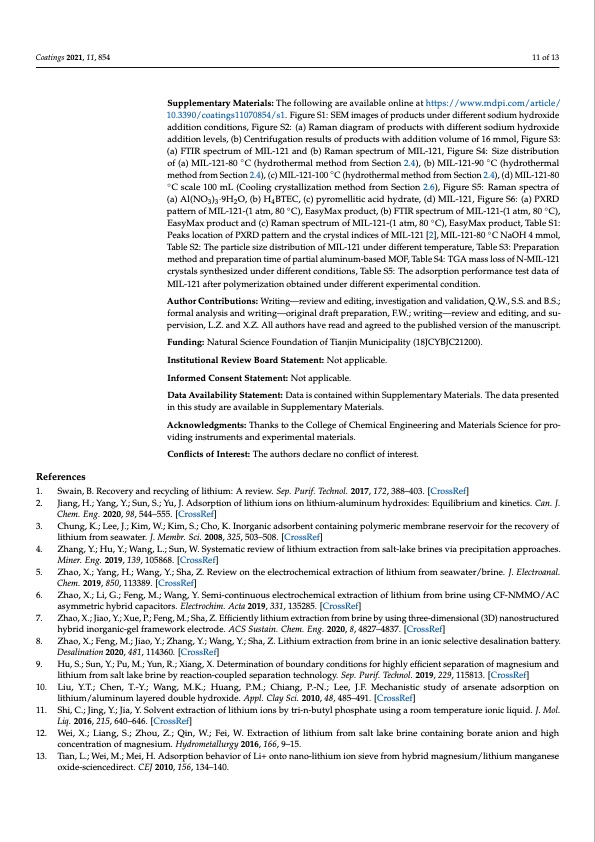
PDF Publication Title:
Text from PDF Page: 011
Coatings 2021, 11, 854 11 of 13 References Supplementary Materials: The following are available online at https://www.mdpi.com/article/ 10.3390/coatings11070854/s1. Figure S1: SEM images of products under different sodium hydroxide addition conditions, Figure S2: (a) Raman diagram of products with different sodium hydroxide addition levels, (b) Centrifugation results of products with addition volume of 16 mmol, Figure S3: (a) FTIR spectrum of MIL-121 and (b) Raman spectrum of MIL-121, Figure S4: Size distribution of (a) MIL-121-80 ◦C (hydrothermal method from Section 2.4), (b) MIL-121-90 ◦C (hydrothermal method from Section 2.4), (c) MIL-121-100 ◦C (hydrothermal method from Section 2.4), (d) MIL-121-80 ◦C scale 100 mL (Cooling crystallization method from Section 2.6), Figure S5: Raman spectra of (a) Al(NO3)3·9H2O, (b) H4BTEC, (c) pyromellitic acid hydrate, (d) MIL-121, Figure S6: (a) PXRD pattern of MIL-121-(1 atm, 80 ◦C), EasyMax product, (b) FTIR spectrum of MIL-121-(1 atm, 80 ◦C), EasyMax product and (c) Raman spectrum of MIL-121-(1 atm, 80 ◦C), EasyMax product, Table S1: Peaks location of PXRD pattern and the crystal indices of MIL-121 [2], MIL-121-80 ◦C NaOH 4 mmol, Table S2: The particle size distribution of MIL-121 under different temperature, Table S3: Preparation method and preparation time of partial aluminum-based MOF, Table S4: TGA mass loss of N-MIL-121 crystals synthesized under different conditions, Table S5: The adsorption performance test data of MIL-121 after polymerization obtained under different experimental condition. Author Contributions: Writing—review and editing, investigation and validation, Q.W., S.S. and B.S.; formal analysis and writing—original draft preparation, F.W.; writing—review and editing, and su- pervision, L.Z. and X.Z. All authors have read and agreed to the published version of the manuscript. Funding: Natural Science Foundation of Tianjin Municipality (18JCYBJC21200). Institutional Review Board Statement: Not applicable. Informed Consent Statement: Not applicable. Data Availability Statement: Data is contained within Supplementary Materials. The data presented in this study are available in Supplementary Materials. Acknowledgments: Thanks to the College of Chemical Engineering and Materials Science for pro- viding instruments and experimental materials. Conflicts of Interest: The authors declare no conflict of interest. 1. Swain, B. Recovery and recycling of lithium: A review. Sep. Purif. Technol. 2017, 172, 388–403. [CrossRef] 2. Jiang, H.; Yang, Y.; Sun, S.; Yu, J. Adsorption of lithium ions on lithium-aluminum hydroxides: Equilibrium and kinetics. Can. J. Chem. Eng. 2020, 98, 544–555. [CrossRef] 3. Chung, K.; Lee, J.; Kim, W.; Kim, S.; Cho, K. Inorganic adsorbent containing polymeric membrane reservoir for the recovery of lithium from seawater. J. Membr. Sci. 2008, 325, 503–508. [CrossRef] 4. Zhang, Y.; Hu, Y.; Wang, L.; Sun, W. Systematic review of lithium extraction from salt-lake brines via precipitation approaches. Miner. Eng. 2019, 139, 105868. [CrossRef] 5. Zhao, X.; Yang, H.; Wang, Y.; Sha, Z. Review on the electrochemical extraction of lithium from seawater/brine. J. Electroanal. Chem. 2019, 850, 113389. [CrossRef] 6. Zhao, X.; Li, G.; Feng, M.; Wang, Y. Semi-continuous electrochemical extraction of lithium from brine using CF-NMMO/AC asymmetric hybrid capacitors. Electrochim. Acta 2019, 331, 135285. [CrossRef] 7. Zhao, X.; Jiao, Y.; Xue, P.; Feng, M.; Sha, Z. Efficiently lithium extraction from brine by using three-dimensional (3D) nanostructured hybrid inorganic-gel framework electrode. ACS Sustain. Chem. Eng. 2020, 8, 4827–4837. [CrossRef] 8. Zhao, X.; Feng, M.; Jiao, Y.; Zhang, Y.; Wang, Y.; Sha, Z. Lithium extraction from brine in an ionic selective desalination battery. Desalination 2020, 481, 114360. [CrossRef] 9. Hu, S.; Sun, Y.; Pu, M.; Yun, R.; Xiang, X. Determination of boundary conditions for highly efficient separation of magnesium and lithium from salt lake brine by reaction-coupled separation technology. Sep. Purif. Technol. 2019, 229, 115813. [CrossRef] 10. Liu, Y.T.; Chen, T.-Y.; Wang, M.K.; Huang, P.M.; Chiang, P.-N.; Lee, J.F. Mechanistic study of arsenate adsorption on lithium/aluminum layered double hydroxide. Appl. Clay Sci. 2010, 48, 485–491. [CrossRef] 11. Shi, C.; Jing, Y.; Jia, Y. Solvent extraction of lithium ions by tri-n-butyl phosphate using a room temperature ionic liquid. J. Mol. Liq. 2016, 215, 640–646. [CrossRef] 12. Wei, X.; Liang, S.; Zhou, Z.; Qin, W.; Fei, W. Extraction of lithium from salt lake brine containing borate anion and high concentration of magnesium. Hydrometallurgy 2016, 166, 9–15. 13. Tian, L.; Wei, M.; Mei, H. Adsorption behavior of Li+ onto nano-lithium ion sieve from hybrid magnesium/lithium manganese oxide-sciencedirect. CEJ 2010, 156, 134–140.PDF Image | Small Particles for Lithium Adsorption from Brine

PDF Search Title:
Small Particles for Lithium Adsorption from BrineOriginal File Name Searched:
coatings-11-00854-v2.pdfDIY PDF Search: Google It | Yahoo | Bing
Product and Development Focus for Infinity Turbine
ORC Waste Heat Turbine and ORC System Build Plans: All turbine plans are $10,000 each. This allows you to build a system and then consider licensing for production after you have completed and tested a unit.Redox Flow Battery Technology: With the advent of the new USA tax credits for producing and selling batteries ($35/kW) we are focussing on a simple flow battery using shipping containers as the modular electrolyte storage units with tax credits up to $140,000 per system. Our main focus is on the salt battery. This battery can be used for both thermal and electrical storage applications. We call it the Cogeneration Battery or Cogen Battery. One project is converting salt (brine) based water conditioners to simultaneously produce power. In addition, there are many opportunities to extract Lithium from brine (salt lakes, groundwater, and producer water).Salt water or brine are huge sources for lithium. Most of the worlds lithium is acquired from a brine source. It's even in seawater in a low concentration. Brine is also a byproduct of huge powerplants, which can now use that as an electrolyte and a huge flow battery (which allows storage at the source).We welcome any business and equipment inquiries, as well as licensing our turbines for manufacturing.| CONTACT TEL: 608-238-6001 Email: greg@infinityturbine.com | RSS | AMP |